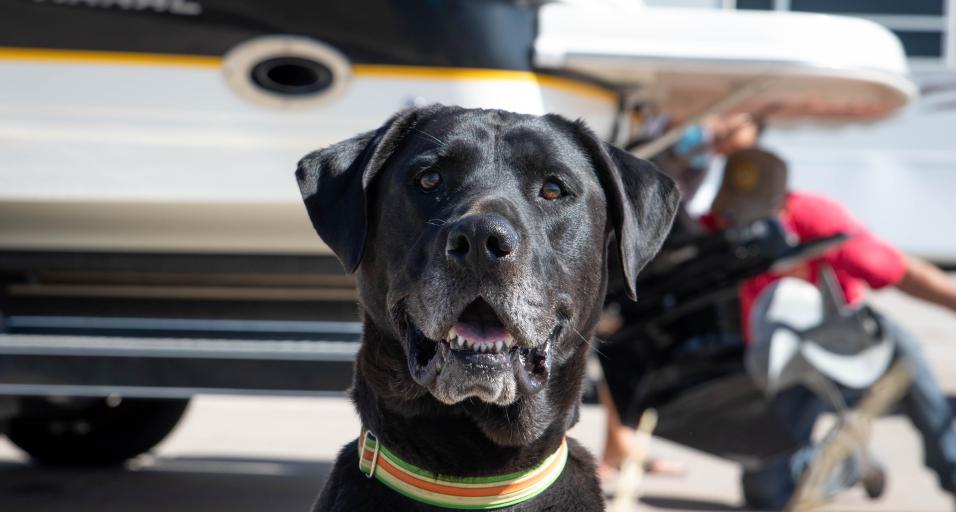Barni goes to work each day refreshed and eager to start his shift. The wait to start the workday is too long for him, and he whines to his coworkers as they wait for some action. Enough sitting and laying around, it’s time to get to work.
Barni isn’t the stereotypical worker, and not only because he whines during a forced 15 minute break. Barni also has four legs, a tail and is covered in fur. Barnacle, nicknamed Barni, is a 5-year-old black lab working on the front lines of Wyoming’s efforts to prevent dangerous aquatic invaders.
While others at aquatic invasive species inspection stations rely on spotting small, invasive mussels in and on boats, the rescue dog is trained to detect zebra and quagga mussels with his nose to help prevent an invasion of these destructive creatures. Zebra and quagga mussels are aquatic invasive species that are dangerous and threatening to freshwater lakes and reservoirs. They cause significant damage to the ecosystem, recreation opportunities, aquatic life, municipal water supplies, agriculture and other commercial activities.
Wyoming is one of only five states in the lower 48 not to have suspected or confirmed populations of these harmful mollusks, and the Wyoming Game and Fish Department wants to keep it that way as long as possible. While the tactics put in place have so far been effective, Game and Fish is always considering new ways to stop AIS from entering the state. In this effort, Game and Fish contracted Debra DeShon’s company, Mussel Dogs, out of Oakdale, California, to come to the state for a week in July to see how effective a mussel-sniffing dog would be at an AIS watercraft inspection station.
Barnacle got to work at the busiest station in the state — the port of entry near Evanston along Interstate 80. About 1,500 boats went through the check station while Barnacle was there, an increase of about 200 from the same time period in 2019. Barnacle put his nose to 257 boats with 15 “hits” or “interests.”
The port of entry near Evanston is one of the key check stations in the state because boaters are entering the state from Utah, which has quagga mussels in one of its most popular waters — Lake Powell. Farther south, Lake Mead in Arizona and Nevada also have these invasive mussels.
“It is pretty much all-hands-on-deck for us here starting July 4 through late summer,” said Jessica Warner, Game and Fish AIS specialist in Evanston.
The check station near Evanston isn't the only one in the state that's seen increased boat traffic. At the state's 14 permanent check stations, along with roving crews at Wyoming waters, inspections are up about 34 percent from this time last year. Through Aug. 30, 2020, 64,681 boats were inspected compared to 48,084 at the same time in 2019. Zebra/quagga mussels have been found on 20 boats this year, 15 of which were in Evanston.
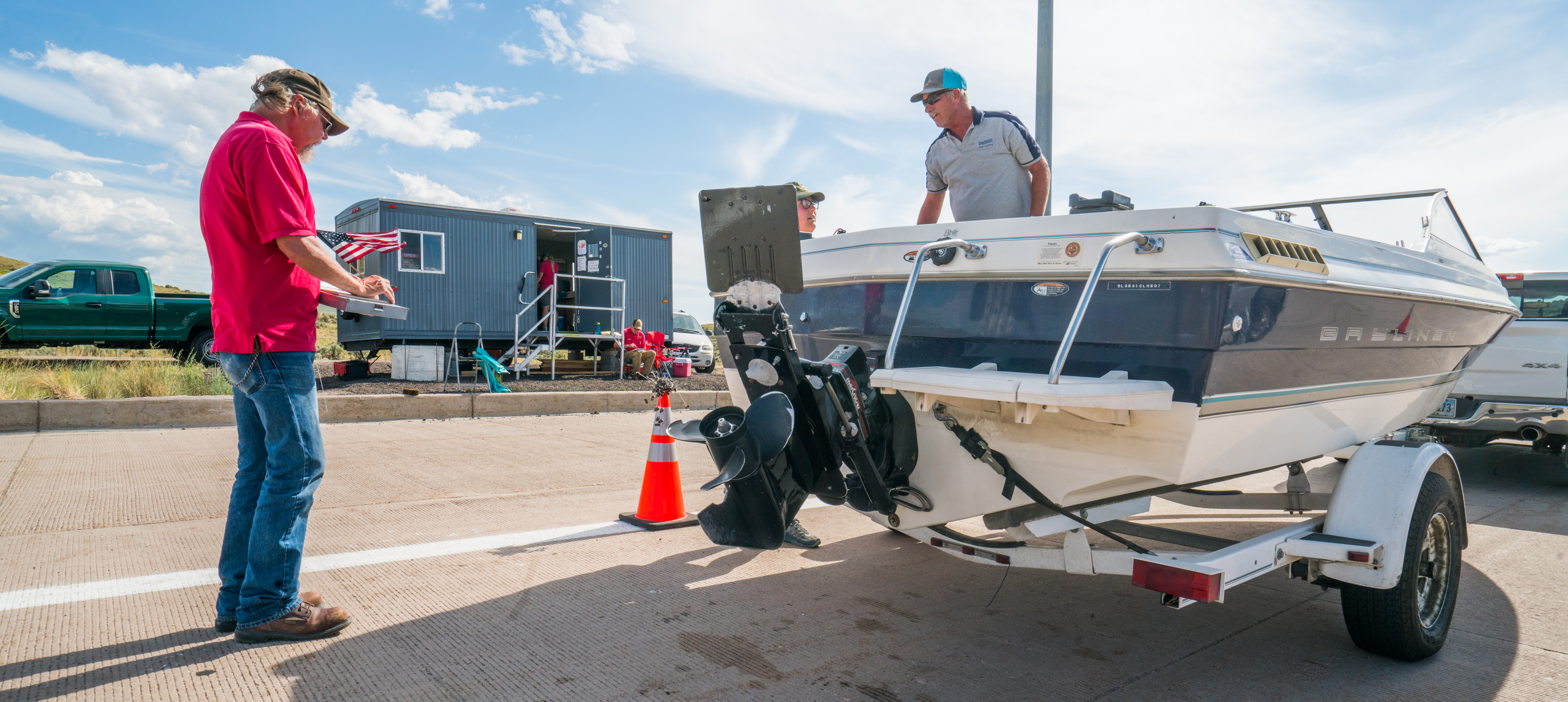 Barnacle’s background
Barnacle’s background
DeShon and her dogs may work as mussel sniffers now, but that wasn’t always the case. DeShon began her career working dogs that detect contraband in schools. She later moved to training dogs to detect mussels. In 2016, DeShon was recognized by the Reduce Risks from Invasive Species Coalition for outstanding achievement by a private sector company in protecting America’s environment and economy.
DeShon currently has 10 dogs to sniff out mussels. She often gets them from rescue centers. Barnacle came from the Bay Area Animal Rescue Crew in Concord, California, near San Francisco. He was 2 1/2 years old when DeShon got him.
“My understanding is he was an owner-surrender, so for whatever reason the owners couldn’t keep him anymore,” DeShon said. “They turned him and his brother into the rescue. The rescue facilities know what I’m looking for. They contacted me, we took him and tested him to see if he had what it takes — and he did.”
What it takes is for the dog to be good around people and to be “ball crazy,” meaning it will fetch a ball all day, any day. The Testing then gets more difficult as a ball is thrown in tall grass for the dog to find. Then it is thrown and the dog is turned in a circle a few times before being let go to find the ball. Eventually, the dog relies more on its nose than sight to find the ball.
For a dog with a good nose and the right temperament, training to detect zebra and quagga odor takes about six weeks. It comes down to teaching a dog to play hide-and-seek, and the prize is the ball. Eventually the scent of zebra/quagga mussels, along with their microscopic larval form called veligers, is associated to the ball.
“I think he has the most focus out of most of the dogs we have,” said Freddy Fahl, DeShon’s son and fellow dog handler. “The way we like to explain it is if you walk into a pizza place you smell pizza. Barnacle walks in and he smells yeast, flour, the pork that went into the pepperoni. He smells everything.”
When Barnacle smelled something suspicious in Evanston, he looked back at DeShon or Fahl, and sat down to signal something may be there.
“He’s just really solid. He’s no-nonsense. He does his job and gets it done,” DeShon said of Barnacle.
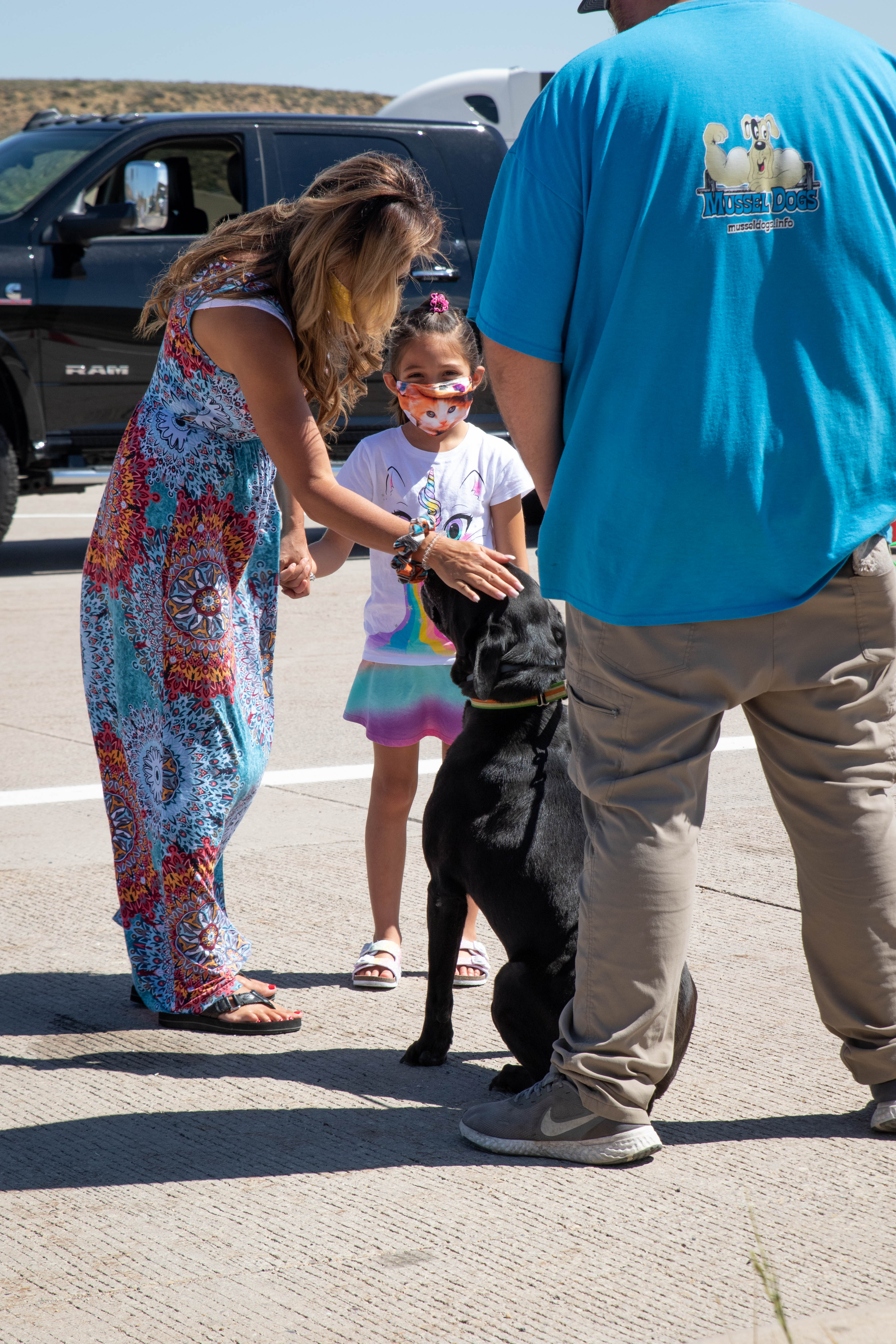 All in a day’s work
All in a day’s work
Barnacle certainly did “get it done” while working at the Evanston inspection station. He took 10 to 15 seconds to sniff a boat, sometimes longer if boats were large. He checked 110 boats on his first day and had three hits or interests — signalling there may be mussels on the watercraft. DeShon said that was a lot of boats in one day for a single dog, but added Wyoming’s milder weather was a welcomed relief compared to the 100-degree heat and high humidity at many of her company’s locales during the summer. She also said Game and Fish’s set up in Evanston and the volume of inspections that can be done at one time made it easy for Barnacle to get a lot of work in when needed.
DeShon said her dogs are trained to go as long as 45 minutes at a time inspecting boats, take a 15 minute break and then get back to work. But just like people, all dogs are different and some fatigue faster or have more stamina and drive than others.
Fatigue didn’t seem to slow down Barnacle.
As the day progressed, Barnacle only was asked to sniff high-risk boats — ones that were recently in waters infested with invasive mussels — so his workload slowed. There were times Barnacle “walked the line” and put his nose to multiple boats lined up for inspections.
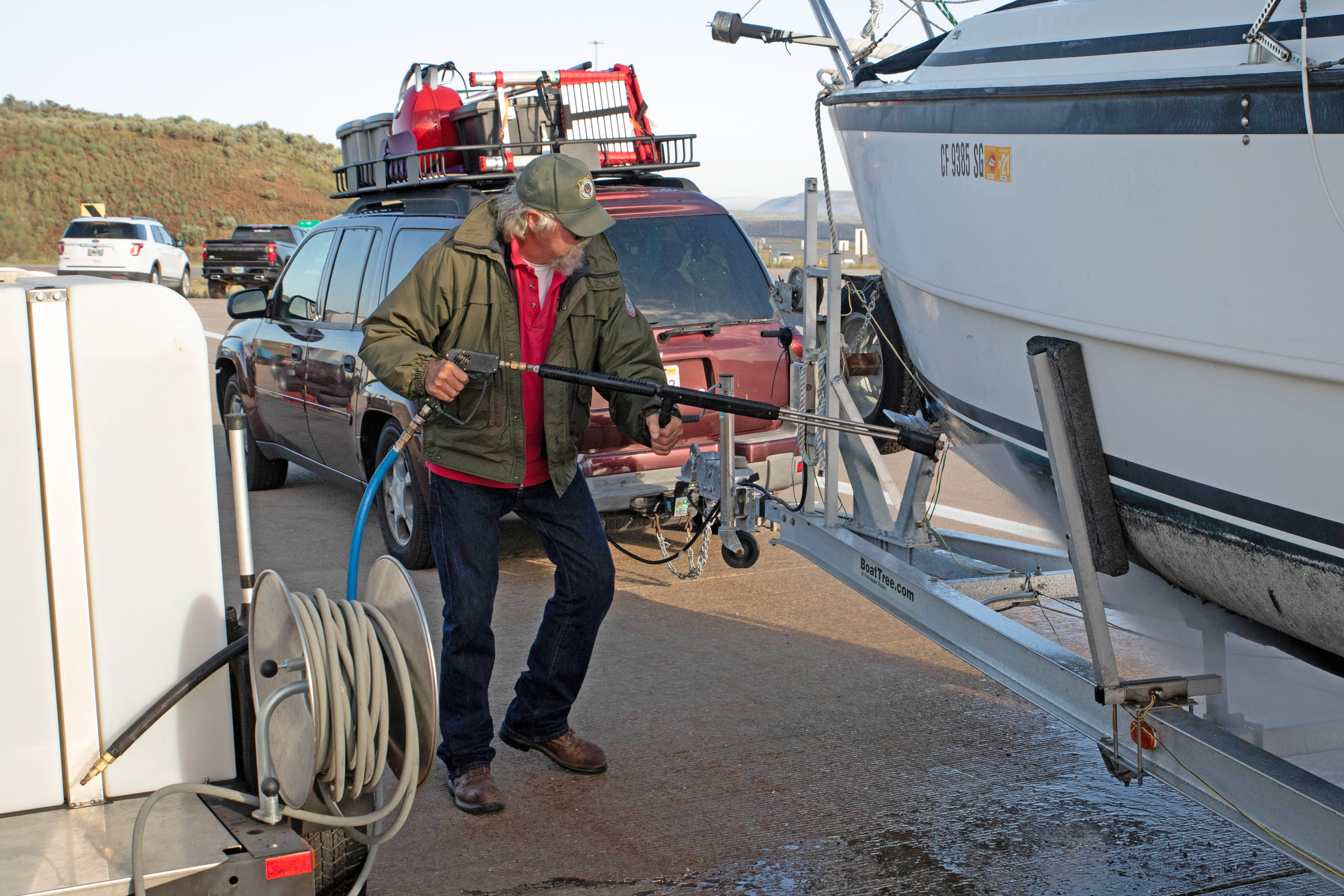 Unique situations
Unique situations
Barnacle’s presence drew attention from the hundreds of people who had their boats inspected. Adults were curious and many kids got the chance to pet the dog.
One morning, Barnacle helped calm a frustrated boater. The man was from Utah and had boated on Lake Powell a couple weeks prior and then was at another Utah water — Jordanelle Reservoir — where there are no signs of zebra or quagga mussels. Staff from the Utah Division of Wildlife Resources decontaminated the boat at Jordanelle, and the boater had the proper paperwork from that inspection. The decontamination took about two hours. He expected to be waved through the Evanston check station.
However, Game and Fish inspects all boats for standing water no matter if a prior decontamination occured. Kevin Gelwicks, Game and Fish assistant fisheries management coordinator, inspected the boat and found a small amount of water in the ballast tanks.Gelwicks didn’t feel like it was enough water for a decontamination, but Barnacle gave the boat the sniff test, and it didn’t pass. Barnacle detected something and since prior to Jordanelle, the boat had been at a high risk waterway, the policy was for Gelwicks to check the boat’s sea strainer. All sea strainers have water in them and are checked to see if mussels are present. The boater started to get impatient because he had to unpack his boat to get to it.
The boater noticed Barnacle when he sniffed the sea strainer, and that calmed him down. Barnacle didn’t detect anything, so Gelwicks was confident the boat didn’t have mussels on board. That resulted in a happy boat owner who was interested in check station procedures. The boater was allowed to continue to his destination without having to go through another decontamination.
“I knew the dog would be a good public relations tool, but I didn’t expect to see him have the calming effect and defuse a tense situation like that,” Gelwicks said. “I also felt the dog was ‘getting my back’ as I did inspections, especially after he was alerted to the ballast water.”
DeShon said she’s seen some odd things when people see a dog at a boat inspection station for mussels.
“I’ve seen people come in, turn around and return with another driver,” she said with a laugh.
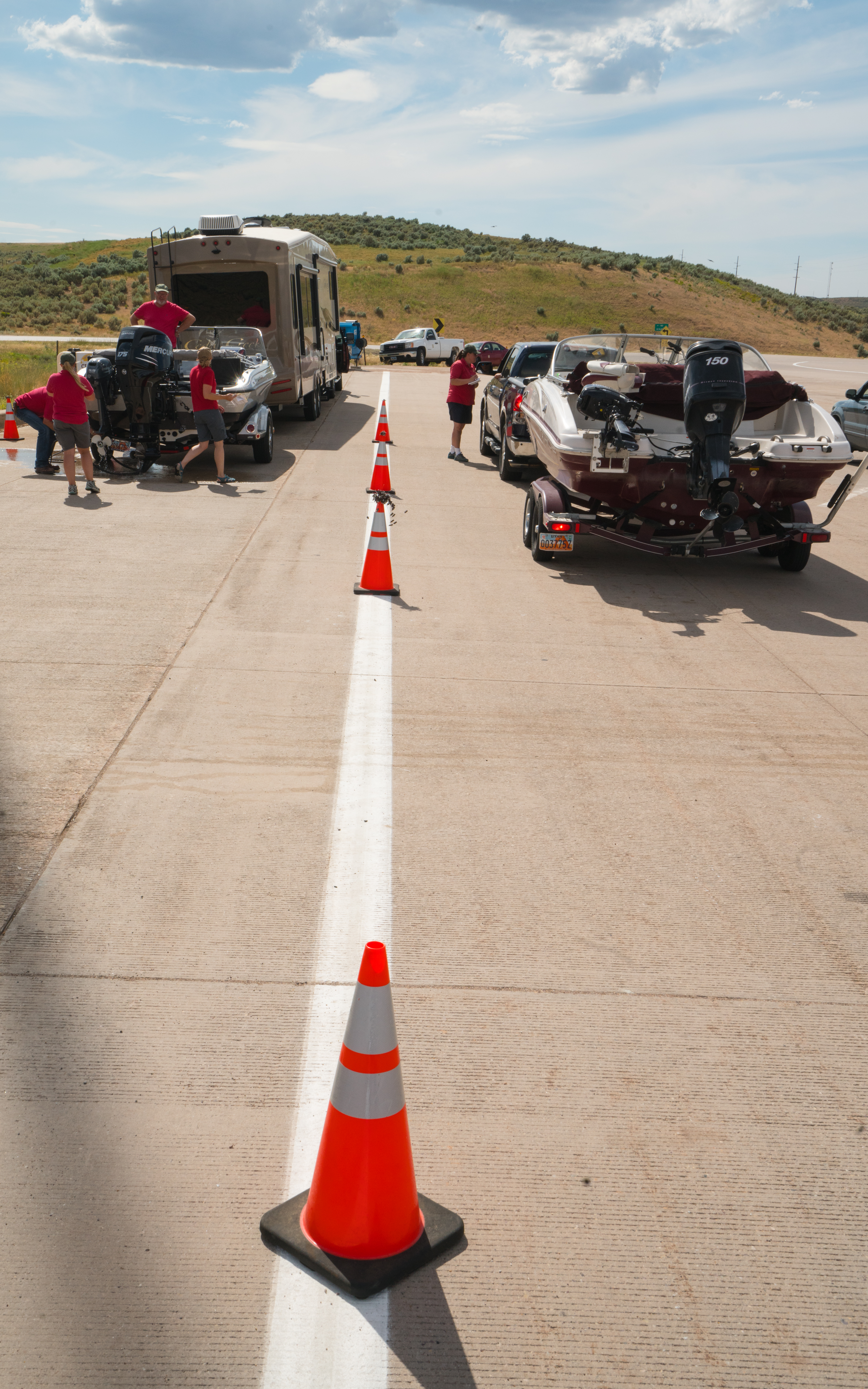 Moving on from here
Moving on from here
Keeping AIS out of Wyoming waters is one of the top priorities for Game and Fish and the conservation community. The Commission has supported the efforts, including the development of AIS Rapid Response plans for at-risk waters in the event of an infestation, and the WYldlife Fund has put forth efforts to raise money for AIS work. Adding a mussel-sniffing dog would be another way to fight that battle.
“It definitely was impressive to see the dog alert on a boat that had mussels or had been in infested waters, but right now we are evaluating this program,” said Alan Osterland, Chief of Fisheries for Game and Fish. “I don’t see us owning a dog yet. I could see us contracting to do it again in another location or another time period. The use of a dog is just another tool in the tool box. It will not replace our inspectors, but certainly has its place. We just have to see if the cost is worth it.”
Warner agreed, and said more research would be key before dogs could be regular workers at Evanston or any other checkstation in Wyoming.
“I do think mussel-detecting dogs have the potential to be an additional tool for the AIS program. However, I feel we owe it to the citizens of Wyoming to exercise due diligence before committing to such a large financial endeavor,” Warner said. The cost of purchasing a dog and taking care of it, along with training, could cost between $20,000 and $30,000.
“Ultimately, our goal will be to determine whether or not the dogs would present a benefit to the program that is not achievable through the resources we already have at our disposal,” Warner added.
Those who saw Barnacle in action can all agree he was good at his job and helped the department to identify more than a dozen boats with potentially harmful invaders aboard.
— Robert Gagliardi is the associate editor of Wyoming Wildlife.

